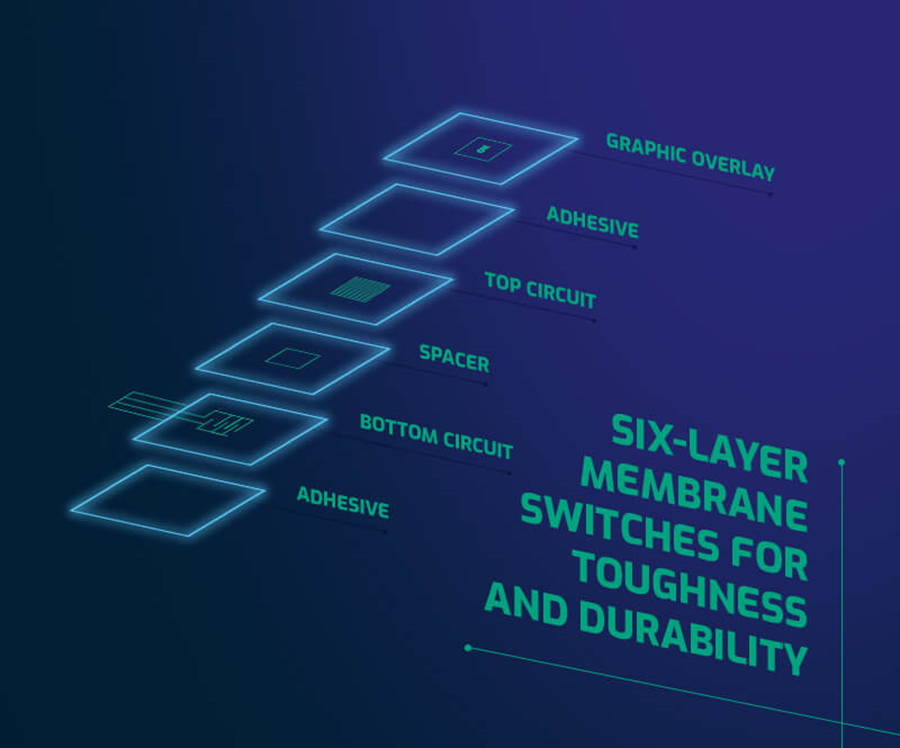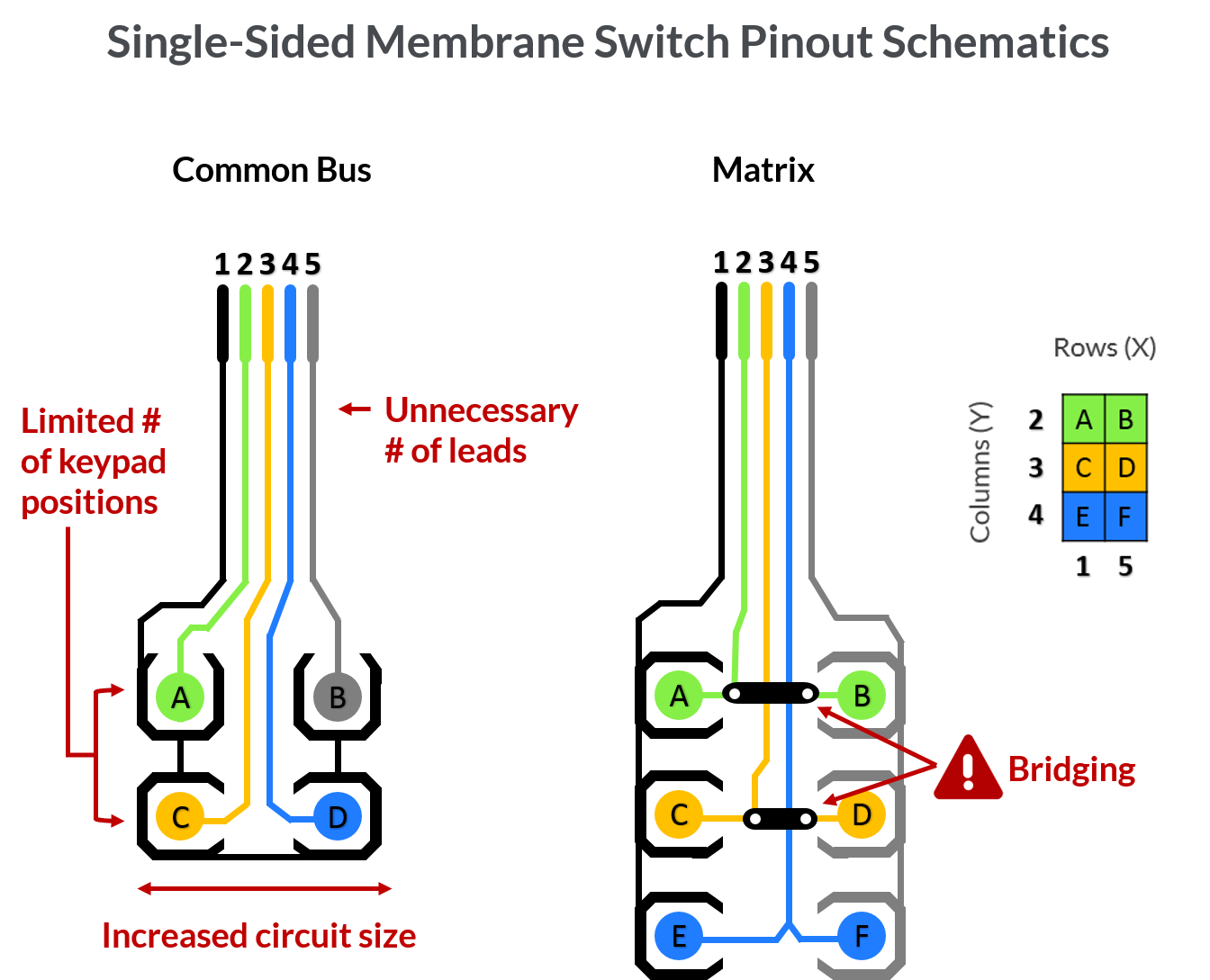The Manufacturing Refine Behind Membrane Layer Change: What You Required to Know
The manufacturing procedure behind membrane switches combines cautious layout, product selection, and quality assurance. It starts with comprehending the details of membrane button style and advances through different phases, including material options and printing techniques. Each phase plays an important function in making certain functionality and durability. The complexities of layer construction and the strenuous screening requirements might disclose understandings that are not instantly noticeable. What exists past these fundamental components?
Comprehending Membrane Layer Switch Over Layout
Although membrane switches might show up basic in the beginning look, their design includes elaborate factors to consider that ensure performance and longevity. The style procedure starts with an extensive understanding of customer demands, including the interface's designated application and environmental aspects. Comfort designs is a key component, as the format needs to promote convenience of usage while ensuring that tactile responses meets individual expectations.Moreover, the layering of components, such as visuals overlays, glue layers, and conductive traces, must be specifically crafted. membrane switch. This split setup not just influences the switch's responsiveness however additionally impacts its long life. Attention is offered to the sealing methods utilized to protect versus wetness and dust, which can compromise efficiency. Furthermore, style factors to consider extend to aesthetic appeals, where color pattern and visual clearness boost user experience. Inevitably, the style of membrane changes balances capability, user experience, and durability, ensuring that they fulfill the needs of different applications effectively
Materials Made Use Of in Membrane Layer Change Manufacturing
When choosing materials for membrane layer switch manufacturing, it is vital to ponder both efficiency and sturdiness. The key materials consist of polyester and polycarbonate films, which provide versatility and strength. These movies are frequently covered with glue to assure proper bonding to substratums. Conductive inks, usually made up of silver or carbon, are crucial for developing electrical connections within the button, permitting reputable operation.Additionally, a safety layer, such as a hard layer, is regularly related to boost scratch resistance and long life. The choice of backing product, such as acrylic or foam, can considerably influence the button's tactile feeling and total customer experience. Furthermore, various ecological factors, consisting of temperature level and moisture, need to guide material choice to assure peak performance in certain applications. Ultimately, the best mix of materials adds to the membrane button's functionality and life expectancy, making educated selections important for makers.
The Printing Process: Creating Video and Text
The printing process in membrane layer button manufacturing plays a substantial duty in producing top quality graphics and message. Different visuals style methods are utilized to assure visual charm and functionality, while mindful ink selection techniques are necessary for resilience and performance. Comprehending these aspects is fundamental for accomplishing best cause membrane switch layout.
Graphic Style Techniques
Graphic style methods play an important duty in the printing procedure of membrane layer buttons, as they define how graphics and text will inevitably appear on the end product. Reliable graphic layout entails the tactical use of layouts, shades, and fonts to enhance readability and visual allure. Designers often utilize vector graphics for scalability, guaranteeing that pictures stay sharp at different sizes. Additionally, attention to contrast and alignment is vital, as it influences individual communication and aesthetic top quality. The consolidation of branding aspects, such as logos, should be handled with like preserve brand name honesty. Generally, thoughtful visuals design methods add substantially to the functionality and beauty of membrane layer buttons, impacting customer experience and item performance.
Ink Option Techniques
Picking the ideal ink is necessary for accomplishing the desired aesthetic quality and durability in membrane layer button manufacturing. Various ink types are used, consisting of solvent-based, water-based, and UV-curable inks. Each type uses unique features, such as resistance, adaptability, and bond to ecological variables. Solvent-based inks are usually preferred for their resilience and vivid shades, while water-based inks are much more environmentally pleasant however might have limitations in adhesion. UV-curable inks offer rapid treating and durable efficiency. Additionally, color matching strategies guarantee that the chosen inks line up with layout specifications. Ultimately, the choice of ink should think about aspects such as application method, substrate compatibility, and end-use requirements to accomplish premium lead to membrane layer switch graphics and text.
Layer Building and Setting Up

Product Selection Refine
A careful selection of materials is important in the production procedure of membrane layer buttons, as it directly influences capability and resilience. The primary materials utilized include polyester, polycarbonate, and numerous conductive inks. Polyester is typically preferred for its excellent resistance to chemicals and abrasion, making it ideal for extreme environments. Polycarbonate, on the various other hand, offers superior quality and influence resistance, which is useful for applications requiring visibility and robustness. Conductive inks, typically made up of silver or carbon, are crucial for producing trustworthy electric paths. Furthermore, the choice of sticky materials affects the overall honesty of the switch - membrane switch. Examining aspects such as ecological exposure, tactile feedback, and aesthetic needs guides producers in choosing the ideal materials for their details applications
Layer Bond Techniques
Adhering layers in membrane layer switch building is an important process that guarantees functionality and long life. Different adhesion strategies are used to safeguard suitable bonding in between layers, which normally include making use of adhesives, warmth, and pressure. Pressure-sensitive adhesives (PSAs) are typically made use of for their simplicity of application and immediate bonding capacities. Additionally, thermal bonding techniques can be applied, where warmth is made use of to activate glue residential or commercial properties, protecting a solid bond. The choice of attachment approach largely relies on the materials entailed and the particular application requirements of the membrane layer button. Proper positioning and consistent application of adhesives are important to protect against problems, securing the button runs properly throughout its designated life expectancy.
High Quality Control Measures
Guaranteeing quality control during the layer construction and assembly of membrane switches is important for keeping efficiency and dependability. This process normally includes several crucial measures, including comprehensive assessments at each phase of manufacturing. Suppliers make use of sophisticated screening approaches, such as peel examinations and bond assessments, to validate the stability of layer bonds. In addition, aesthetic examinations are performed to identify any defects in printing or material incongruities. Ecological problems, such as temperature level and humidity, are thoroughly monitored to assure perfect healing and bond. Normal calibration of tools helps keep precise manufacturing standards. By executing these quality assurance procedures, suppliers can significantly decrease the risk of item failure, assuring that the final membrane layer switches over fulfill the needed specs and client assumptions.
Evaluating and Quality Assurance Procedures

Technologies in Membrane Change Technology
As improvements in technology proceed to advance, membrane layer switches are gaining from ingenious advancements that improve their performance and customer experience. One notable advancement is the combination of capacitive touch innovation, which allows for more responsive and instinctive interface. This change not just boosts appearances but likewise reduces mechanical wear and tear, extending the life expectancy of the switches.Additionally, improvements in visuals overlay products have actually resulted in boosted sturdiness and resistance to environmental aspects such as moisture and UV light. These products currently use improved quality and brightness, more raising the visual appeal.Furthermore, the consolidation of clever technology is changing membrane switches into interactive control board, enabling connection with IoT gadgets. This connectivity fosters a seamless user experience, leading the means for applications in different markets, from health care to customer electronics. Collectively, these advancements position membrane layer changes as important components in contemporary device layout.
Often Asked Concerns
The length of time Does the Membrane Switch Production Process Take?
The duration of the membrane switch production procedure can differ considerably. Elements such as intricacy, products made use of, and production volume influence timelines, with common production varying from a few days to several weeks for completion.
What Are the Typical Applications for Membrane Layer Buttons?
Membrane buttons are generally used in various industries, including auto controls, family appliances, clinical tools, and consumer electronics (membrane switch). Their versatility and sturdiness make them optimal for applications calling for straightforward user interfaces and trusted performance in diverse environments
Can Membrane Layer Switches Over Be Custom-made for Specific Needs?

What Is the Life expectancy of a Regular Membrane Switch Over?
The life-span of a regular membrane layer button varies, yet usually, it ranges from 1 to 5 million cycles. Aspects such as usage, atmosphere, and material top quality substantially influence longevity and general check my site performance gradually.

Are Membrane Changes Eco Pleasant?
The environmental kindness of membrane switches differs. Some products used might not be recyclable, while others can be green. The total effect depends on manufacturing practices and products, requiring mindful factor to consider during option and disposal. The manufacturing process behind membrane changes combines careful layout, material option, and high quality control. It starts with understanding the details of membrane layer button design and advances via numerous phases, including material selections and printing methods. When picking materials for membrane layer switch production, it is vital to contemplate both performance and longevity. A cautious selection of products is crucial in the production procedure of membrane layer buttons, as it directly affects functionality and sturdiness. The option of bond approach largely depends on the materials involved and the details application needs of the membrane switch.